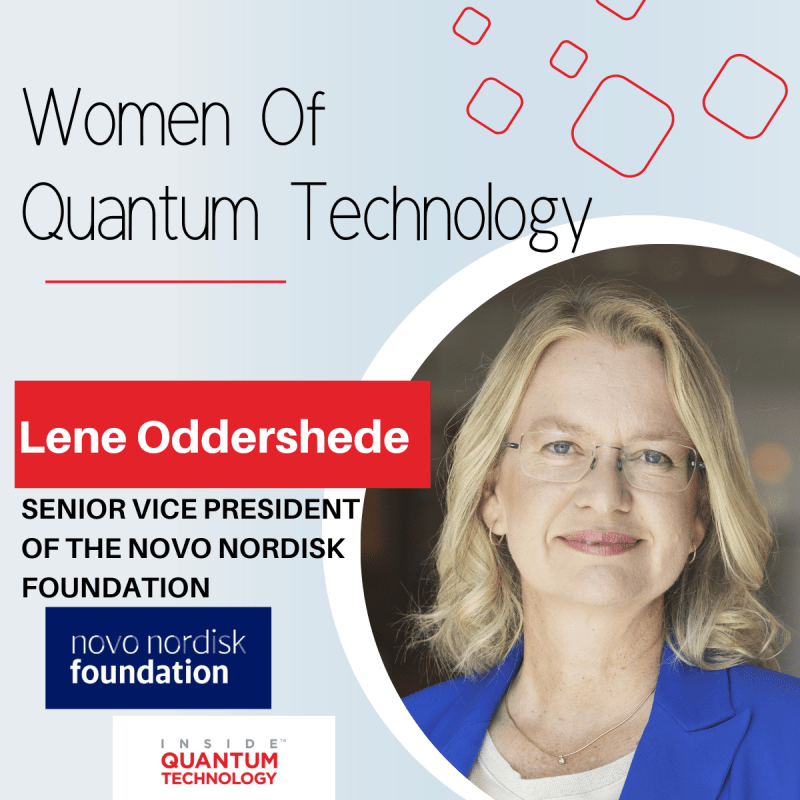Women of Quantum Technology: Dr. Lene Oddershede of the Novo Nordisk Foundationology: Dr. Lene Oddershede of the Novo Nordisk Foundation

Like many different technology industries, the quantum industry boasts a high percentage of individuals with a background in either research or academia. One of these individuals is Dr. Lene Oddershede, the Senior Vice President at the Novo Nordisk Foundation. While the Foundation itself isn’t exactly what Oddershede classifies as “industry,” it still plays a unique role in bridging the gap between industry and research. “It’s what we in Denmark call an Enterprise Foundation,” Oddershede explained. “They’re quite normal in Denmark. So the Novo Nordisk Foundation has what we call an ‘engaged ownership’ of the global Novo companies, which includes Novo Nordisk and 148 other companies.” Other Enterprise Foundations include the Lego Foundation. Because the Novo Nordisk Foundation uses a part of its companies’ profits to help create financial opportunities for innovative research, Oddershede is always looking ahead. “In my current job, I need to be some steps ahead of research because I need to make opportunities for researchers to bloom,” she added.
It’s easy to say that Oddershede has had a long and rich relationship with quantum science. “Ever since I had my first course in quantum, I always thought that it was really interesting and different,” Oddershede said. After receiving her Ph.D. in physics in 1998, Oddershede became a research leader and tenured professor at the Niels Bohr Institute at the University of Copenhagen. “Throughout my career, I’ve been an experimental physicist,” Oddershede stated. “I have built equipment myself, like optical tweezers and I’ve worked very closely with researchers from the life sciences, as well as medical doctors. So, this bridge between physics and biology, or medicine, has always been something that I have worked towards, which is personally very important to me.” Oddershede continued to carry that passion for the life sciences into her current position at the Novo Nordisk Foundation.
Now as Senior Vice President, Oddershede looks for new innovative technology for the Foundation to support and mentor. According to Oddershede, she is “heading a group of creative and devoted people who work on this team. There is a lot of room for establishing connections to the research community, and being in close contact with researchers, with industry, and with a number of stakeholders, I think that’s a really exciting part of my job.” In looking for new innovative technology to support, Oddershede attends conferences and visits labs. With her focus on health sciences and medicine, she hopes to find the next generation of technology to better human health. “I kind of have to look in the crystal ball and see where the next areas for mankind and for society are within health and sustainability,” added Oddershede.
It was no surprise that one of these technologies to look into was quantum computing. “We’ve focused on quantum for the last three years,” Oddershede explained. “And we’ve had a number of exciting activities which we’ve started.” One of these was the recent $200 million pledge by the Novo Nordisk Foundation to develop a quantum computer for the life sciences. “I’m really excited to work for the quantum part of the Foundation,” Oddershede added. Because the Novo Nordisk Foundation creates opportunities like the new quantum program, they incentivize creation of companies and their business in Denmark, helping the country’s economy and overall community.
In looking at the quantum community, whether in industry or research, Oddershede believes that changes need to be made. With her extensive background in academia, Oddershede posits that it would benefit the quantum industry to be more inclusive. “It seems quantum is the area of physics that has the smallest number of females,” Oddershede said. “And I believe it already starts at the Ph.D. level and gets worse the further you progress upwards in the academic system or in industry.” To try to bring more awareness to this issue and create more role models for future female quantum scientists, Oddershede suggests that both universities and quantum companies purposely look for, or “head hunt,” these female scientists. According to Oddershede, “this means that sometimes universities may have to be a little bit braver and take female researchers that are younger because there are more individuals at that level, and to look at these individuals also for their potential, not only their achievements.” Because the quantum industry is struggling with a talent shortage, Oddershede emphasizes that academia is the key place where the bottleneck can be widened to include more women and other minority groups. “I think the second that academia produces more quantum experts of both genders and all backgrounds, it will benefit the industry,” she stated.
Kenna Hughes-Castleberry is a staff writer at Inside Quantum Technology and the Science Communicator at JILA (a partnership between the University of Colorado Boulder and NIST). Her writing beats include deep tech, the metaverse, and quantum technology.



















